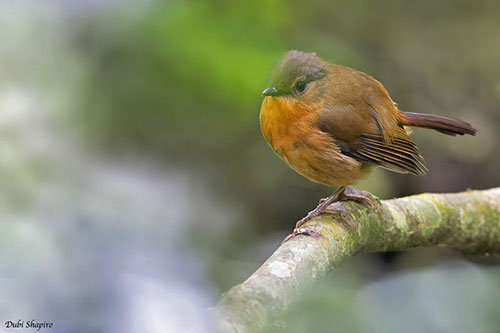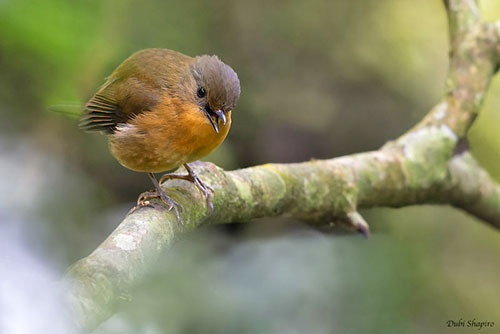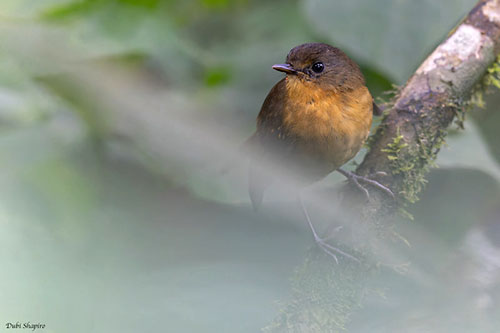
PROTECTION / THREATS / STATUS:
The Rubeho Akalat is threatened by logging of large trees and forest clearance. Although the range of this species includes one of the largest intact blocks of forest in the Eastern Arc Mountains, both degradation and fragmentation of the habitat probably affect the species which is restricted to montane forest at high elevation.
The size of the population is unknown and is suspected to be slowly declining.
The Rubeho Akalat is described as fairly common, but currently, the species is classified as Endangered.
Fr: Rougegorge des Rubeho – Rougegorge de Tanzanie
Ang: Rubeho Akalat
All: Rubehorötel
Esp: Akelat de Rubeho
Ita: Akalat dei Rubeho
Nd: Rebuhojanfrederik
Sd: rubehoakalat
Photographer:
Dubi Shapiro
Dubi Shapiro Photo Galleries
Text by Nicole Bouglouan
Sources:
HANDBOOK OF THE BIRDS OF THE WORLD Vol 10 by Josep del Hoyo-Andrew Elliott-David Christie - Lynx Edicions - ISBN: 8487334725
HANDBOOK OF THE BIRDS OF THE WORLD Vol 11 by Josep del Hoyo, Andrew Elliott and David Christie - Lynx Edicions - ISBN: 849655306X
Birds New to Science: Fifty Years of Avian Discoveries Par David Brewer – Editeur: Bloomsbury Publishing, 2018 – ISBN: 1472906292, 9781472906298 – 416 pages
Robins and Chats by Peter Clement – Editeur: Bloomsbury Publishing, 2016 – ISBN: 1408155974, 9781408155974 – 688 pages
Birds of the World
CREAGUS@Monterey Bay (Don Roberson)
Fatbirder - The World’s Richest Information Resource about Birds for Birders
A New Species of Akalat (Sheppardia) Narrowly Endemic in the Eastern Arc of Tanzania
Wikipedia, the free encyclopaedia
Rubeho Akalat
Sheppardia aurantiithorax
Passeriformes Order – Muscicapidae Family
INTRODUCTION:
The Rubeho Mountains are located in C Tanzania. It is one of the least explored and understudied region in the Eastern Arc Mountains, and several endemic birds, among them the Rubeho Akalat, are living in reserves. These mountains include a main highland area and several ridges and massifs.
The Rubeho Akalat is endemic to the Eastern Arc Mountains of Tanzania. It frequents the undergrowth of montane forest between 1,800 and 2,200 metres of elevation.
The breeding behaviour is unknown but the breeding season takes place at the beginning of the rainfalls, when insects are available.
The Rubeho Akalat was described in 2004. It is closely related to the Iringa Akalat (S. lowei). The ranges of these species are separated by the Great Ruaha River in Tanzania.
The Rubeho Akalat is considered Endangered due to habitat loss and fragmentation.
DESCRIPTION OF THE BIRD:
Biometrics:
Length: 14 cm
The Rubeho Akalat is a typical species of the family Muscicapidae, with robust legs and upright posture.
On the upperparts, mantle to lower back, scapulars and wing-coverts are bright copper-brown with dark grey feather bases. Both rump and uppertail-coverts show a conspicuous coppery wash. The tail is uniformly brown with coppery wash too. On the upperwing, greater coverts and tertials have bright copper edges, whereas the inner webs are greyer. The flight-feathers are dull brown with copper tips and edges.

On the underparts, the white chin becomes ochre-yellow to deep orange on throat to sides and lower breast. Flanks and undertail-coverts are mostly tawny-olive. Belly and vent are white to creamy-buff. On the underwing, the coverts are dull ochre-yellow.
On the head, forehead to nape is blackish-grey with tawny-olive wash. The area from lore to eye is whitish with brown tips. Cheeks and ear-coverts are brown with pale spots or saffron-yellow wash.
The bill is black. The eyes are dark brown. Legs and feet are grey with ochraceous soles.
Male and female are similar.
The juvenile plumage is unknown. However, a bird seen in June in post-juvenile moult resembles adults, but crown and face are spotted yellowish-orange. Cheeks, chin and throat show large orange spots with browner fringes. Mantle and wing-coverts show similar pattern.
RANGE:
The Rubeho Akalat is found in C Tanzania in Rubeho highlands, Wota Forest (Wota Mts in NW Rubeho), Ukaguru Mts and on Mount Kiboriani at 1,600/2,400 metres of elevation.
HABITAT:
The Rubeho Akalat frequents the understorey of montane forests, mainly the dry plateau and secondary growths at high elevations (1,800/2,200 metres).
CALLS AND SONGS: SOUNDS BY XENO-CANTO
The Rubeho Akalat gives a series of dry, nasal rattles “t-t-t-rrrr” repeated for long periods. It also produces varied rattling calls with low smacking “tjytjy-tjyt”. The song is unknown.

BEHAVIOUR IN THE WILD:
The Rubeho Akalat feeds primarily on arthropods. It forages on the ground or in low vegetation in the undergrowth.
The foraging behaviour is a typical “watch-and-pounce” action. Like numerous Muscicapidae, it also pursues small prey with short dashing flights. It may attend driver-ant swarms too (genus Dorylus).
The breeding behaviour is unknown. The breeding season is closely associated with food availability, especially invertebrates, and often takes place at the beginning of the rainy season.
The courtship behaviour of the members of this family often involves courtship feeding by male to female. The male also flicks both wings and tail while singing.
The nest is usually an open cup placed in tree, often in dense foliage.
The Rubeho Akalat probably performs some altitudinal movements after breeding, during the dry season.
These movements imply the ability to fly over more than 100 kilometres above the lowland savanna.
REPRODUCTION OF THIS SPECIES:
The eggs are probably laid in March-April, at the start of the rainy season.
Usually, the Muscicapidae build an open cup-shaped nest in trees, as they are mainly arboreal species. The nest is generally built by the female.
The clutch size is usually 2-3 eggs in tropical and subtropical species. The chicks are altricial and fed by both parents. More study is required.
